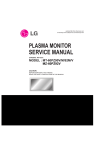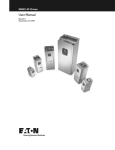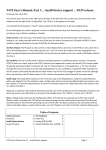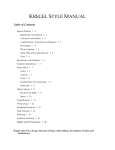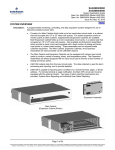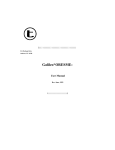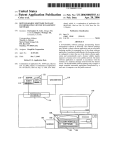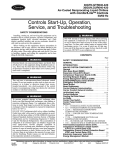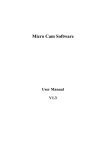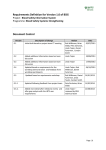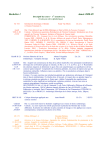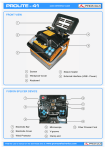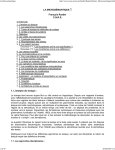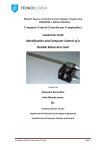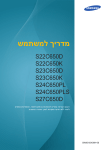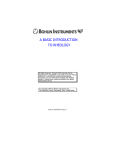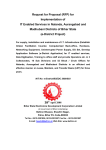Download English-to-Hebrew Software (E2H)
Transcript
English-to-Hebrew Software (E2H) E2H User’s Manual with Selected Answers to the English-to-Hebrew and Hebrew-to-English Exercises for J. Weingreen’s A PRACTICAL GRAMMAR FOR CLASSICAL HEBREW GRAMMAR, 2ND ED. Stephen S. Rives Last updated May 2009 J. Weingreen’s book, A P RACTICAL GRAMMAR FOR CLASSICAL HEBREW GRAMMAR, 2 ND ED., presents students with Hebrew-to-English and English-to-Hebrew exercises. The book was published in 1959 without an answer key. It was also published before the invention of TrueType fonts, PDF files, Internet distribution, and all the rest. With the advent of such things, it is now reasonable for individuals to publish their own answers. My answers are not meant to be a key, but I do make them available. They were entered into the computer with the aid of the MS-Windows software called EnglishToHebrew.exe (or simply, E2H). That software may be more valuable than any particular set of answers, and a major objective of this document is to provide a user’s manual for E2H. E2H is designed to allow seamless entry of both English and Hebrew within one software package. The software remembers what the user types and builds an English-to-Hebrew database or lexicon. In this way, when a user types an English word or phrase that has been entered before, the Hebrew equivalent is retrieved and automatically displayed. If the software cannot locate the English word, the user then provides the Hebrew equivalent. The pair of words are associated and stored and will be available the next time the English is entered. In this way, the database is an English to Hebrew dictionary. This document is laid out such that the first section is a User’s Guide for E2H. The second section contains answers to Weingreen’s exercises. Appendixes on Hebrew Articles and on Hebrew Fonts are provided at the end of this manual. 1 E2H User’s Manual www.MrRives.com I. E2H Software User’s Guide The English-To-Hebrew software (simply E2H) is available on this Internet site: www.MrRives.com To use it, the SBL Hebrew font must be installed on the user’s computer along the SBL Hebrew keyboard driver – all downloadable from the Society of Biblical Literature web site (instructions will be given below). Using E2H involves a process of keying in English/Hebrew word pairs (or translation mappings). As the user goes through this process of teaching E2H the mappings from English to Hebrew, a database is being built. By the end of Weingreen’s grammar, the student will have built the English-to-Hebrew database and will be proficient in keying in Hebrew. There is no constraint within E2H regarding which grammar or workbook it is used with; it is not limited to Weingreen. When one enters an English word into E2H, followed by the [TAB] key (where [TAB] is the way one moves between fields), the program will retrieve the Hebrew equivalent to the English word. If it has not seen the English before, then the user must provide the Hebrew equivalent, thus building the English-to-Hebrew lexicon. The software does not check the validity of the words entered, and so the adage holds: garbage in, garbage out. E2H is no better than the user’s knowledge of Hebrew. In my own use of the software, I have invented a system of declined English. I can type in certain English phrases and get out a declined Hebrew equivalent. Adjectives in Hebrew can be feminine or masculine, as in the case of the word evil, which can modify a masculine or feminine word. I would type “evil (f)” if the word being modified is feminine. Likewise, the English format I use for more complex mappings follows the pattern of this example: (m) your (f) When I type that into the English input box, I am signifying that I need an ending attached to a masculine (m) noun, and I want that ending to be the feminine (f) for "your". As a convention, I use the English word "Thy" to specify the Hebrew singular version of your. I use the English word "Your" to specify the Hebrew plural version of your. Thus, as an example, the following yield different results: (m) your (f) (m) thy (f) (m) thy (m) 2 E2H User’s Manual www.MrRives.com The third of those three means I want the masculine ending for “thy” added to the end of masculine Hebrew noun. In response, E2H would return the Hebrew value stored in the Lexicon, which I have pre-loaded as: ְָך. One can examine the mappings by pressing the “Edit Lexicon” button. One does not need to use my system of mapping because the software is flexible enough that anyone can invent their own system. Additional Help on the SBL Fonts and using a Hebrew Keyboard: The user needs the right fonts in order to use E2H. Within E2H, press the [About] button and notice the various links that will take one to instructions regarding how to configuring a computer for Hebrew use. It takes about an hour to fully configure MS-Windows for both English and Hebrew fonts and keyboards. A. Basic Usage E2H follows a four-step usage pattern (the numbers 1., 2., 3., 4. remind the user of the steps they need to take). Step 1: Enter an English word or phrase Step 2: Press the [TAB] or [Enter] key – this will place the cursor in the “Enter Hebrew Equivalent:” box. Step 3: Enter the Hebrew phrase that matches the English phrase Step 4: Press the [TAB] or [Enter] key – this will add the mapping to the database of mappings and then move the cursor back to the “Enter English Phrase or Word:” box. In the following screen, steps 1, 2 and 3 have been followed: 3 E2H User’s Manual www.MrRives.com The English word, “Saw”, was entered in Step 1, then the TAB was pressed (Step 2) which took the cursor to the “Enter Hebrew Equivalent:” box. In Step 3, ָש ָאהwas keyed in. Now we are ready to press TAB again (Step 4) – which stores the mapping of Saw to ָש ָאהin the Lexicon. Pressing TAB also takes the user back to the “Enter English Phrase or Word:” so that the process can be repeated: Following these four steps, one continues to enter English phrases until the sentence or exercise is completed. The sentence, “The King saw the woman in the Temple” was entered into the software: To end the sentence properly, a “:” marker was entered. It is still up to us to edit the sentence, however, and place the final word, ַ ַּֽב ֵה ָיכלin pause. 4 E2H User’s Manual www.MrRives.com B. Advanced Options E2H is designed to have a simple four-step interface (as described above). More advanced options are available and accessed through the various buttons and checkboxes visible on the main screen: Following is a description of each of the buttons and their corresponding functions. [ ] Help Checkbox: The E2H program will Help the user by displaying the Hebrew phrase that matches an English input. However, if Help is turned off (if this check-box is unchecked), then the user will have to supply the Hebrew equivalent even if that Hebrew equivalent is available to E2H in the lexicon. By turning off Help, the user is able to gain the benefit of repetition (repeatedly entering Hebrew phrases). Important: When Help is turned off, the lexicon will still be updated with the English Hebrew mappings in the cases where the mapping is not already in the lexicon. [ ] Auto-copy Hebrew to Clipboard Checkbox: This check-box will cause E2H to copy the most recent Hebrew sentence into the clipboard after each pass through Step 4. In this way, the latest Hebrew phrase is always ready to be pasted into MS-Word or any other word processor that supports the SBL Hebrew font. 5 E2H User’s Manual www.MrRives.com [Reset Screen] button (also activated by pressing Alt+R): Pressing this button will erase all the visible fields on the current screen and prepare the user to enter the next phrase. Pressing this button will not reset or erase any data in the lexicon/database. [Undo Last] button (also activated by pressing the key combination Alt+U): Pressing this button will remove the last word typed into the English box along with subtracting the corresponding Hebrew equivalent from the sentence. This will not remove the word from the Lexicon/database. By doing Step 4 (pressing TAB), the mapping of English to Hebrew is stored. The only way to undo an entry in the database is to [Edit the Lexicon]. [Edit Lexicon] button: Pressing this will bring up a Notepad version of the English-toHebrew mappings. This file is the database of the user’s input. Be careful with this! One can safely edit and save this file. However, it is not advisable to continue doing Steps 1 through 4 while this file is open. The user should Edit the Lexicon, save any changes then return to doing Steps 1 through 4. [About] button: This button displays the version of the program and also gives buttons that lead to instructions on how to configure Hebrew Fonts on a PC. Notice also on the about screen that the version of the software you are using is displayed. In this case, it is version 1.0.5.26.09. That is version 1.0, last built on May 26, 2009. The web site has the latest version for download. If you are a registered user, then you may be eligible to receive free upgrades. 6 Answers to J. Weingreen’s, A Practical Grammar, 2nd ed. www.MrRives.com II. Selected Answers to Weingreen’s Grammar Following are selected answers to Englishto-Hebrew and Hebrew-to-English. Many of the English answers were compared to a key that comes from C. John Collins via his students. The answers in Hebrew are provided without the advantage of being validated against another source, and likely contain errors. The selected answers trail off to fewer and fewer as the book progress. It would take considerable time to complete every exercise. In the Hebrew answers, words have been placed in pause using the סֹופ ָפסּור, “end of verse”, sign, ׃, along with the ִסּלּורmarker, ְַּֽ . Likewise, the ַאתנָ ח, ְ֑ , is used as a logical divider when possible (see pages 20-21 in Weingreen for further explanation). Words that are accented ִמל ֵףילare shown with the accent on their tone syllable; the reason for this is that I generally enter such words into E2H with accents. 7 Answers to J. Weingreen’s, A Practical Grammar, 2nd ed. www.MrRives.com Exercise 1 (The Article), Page 26 (1) a king, the king (2) a day, the day (3) a night, the night (4) a light, the light (5) a city, the city (6) a head, the head (7) darkness, the darkness (8) a temple, the temple (9) dust, the dust (10) the day and the night (11) the light and the darkness (12) a king and a man, the king and the man (13) ground and dust, the earth and the dust (14) a city and a temple, the city and the temple (15) God created a man from the earth (16) the King came from the temple (17) God said to the man (18) And to the city the king came (19) God created light from the darkness. (1) ַה ַּלי ָלה, ַלי ָלה (2) ַהּיֹום, יֹום (3) ָ ַּֽה ָא ָדם, ָא ָדם (4) ֹלהים ִ ָה ֱא, ֹלהים ִ ֱא (5) ָה ֲא ָד ָמה, ֲא ָד ָמה (6) ַ ַּֽה ֵה ָיכל, ֵה ָיכל (7) חשְך ֶ ַה, חשְך ֶ (8) ָ ַּֽה ָף ָץש, ָף ָץש (9) ֹלהים ו ַה ֶֶּ֫מ ֶלְך ִ ֱא (10) ַ ַּֽה ֵה ָיכל ו ָה ִףיש (11) ָ ַּֽה ָא ָדם ו ָ ַּֽה ֲא ָד ָמה (12) חשְך ו ָהאֹוש ֶ ַה (13) ן־ה ֲא ָד ָ ַּֽמה ׃ ַּֽ ָ ָב ָשא ָא ָדם ִמ (14) ל־ה ֶ ֶַּּֽ֫מ ֶלְך ׃ ַ ֹלהים ֶא ִ ָא ַמש ֱא (15) ל־ה ִ ַּֽףיש ׃ ָ ָבא ָ ַּֽה ָא ָדם ֶא (16) חשְך ׃ ַּֽ ֶ ָבא ַה ַּלי ָלה ו ַה (17) ֹלהים ׃ ַּֽ ִ ל־ה ָא ָדם ָא ַמש ֱא ַּֽ ָ ו ֶא (18) ן־ה ִ ַּֽףיש ׃ ָ ָבא ַה ֶֶּ֫מ ֶלְך ִמ (19) ל־ה ָף ָץש ַּֽ ֶ ֶא (20) ן־ה ֵה ָיכל ַּֽ ַ ִמ 8 Answers to J. Weingreen’s, A Practical Grammar, 2nd ed. www.MrRives.com Exercise 2 (The Inseparable Prepositions), Page 30 (1) a king, to a king, from a king; the king, to the king, from the king (2) a man, as a man, from a man, the man, as the man, from the man (3) the temple, in the temple, from the temple (4) the darkness, to the darkness, as the darkness (5) dust, from dust, the dust, in the dust, from the dust (6) God, as a god, from God, the God, as the God, from the God (7) Yahweh, to Yahweh, from Yahweh (8) ground, as the ground, the ground, as the ground (9) Samuel, to Samuel, as Samuel, from Samuel (10) God called the light day and the darkness he called night (11) The people walked in the darkness and did not see light (12) Samuel gave a king to the people (13) Yahweh saw from the heavens (14) God created a man from dust a woman from the man (15) Samuel spoke to the people. The king came to the city. (16) God called to Samuel in the night (17) God gave a woman to the man (18) Yahweh is king in the Heavens (19) The king walked to the temple in the night (20) God gave light to the man and to the woman (21) The king did not speak a word to Samuel (22) Samuel called to Yahweh (23) Yahweh did not give light to the people (24) Samuel walked in the city (25) Yahweh saw in Samuel a head/leader for the people (1) יֹום ביֹום ִמן־יֹום ַהּיֹום ַבּיֹום ֵ ַּֽמ ַהּיֹום (2) ן־א ָשה ָ ַּֽה ִא ָשה ָ ַּֽל ִא ָשה ֵמ ָ ַּֽה ִא ָשה ִ ִא ָשה ל ִא ָשה ִמ (3) ן־ףיש ָה ִףיש ָכ ִףיש ֵ ַּֽמ ָה ִףיש ִ ִףיש כ ִףיש ִמ (4) ַה ֶּ֫חֹ֫ח ֶשְך ַב ֶּ֫חֹ֫ח ֶשְך ֵ ַּֽמ ַה ֶּ֫חֹ֫ח ֶשְך (5) ֹלהים ִ ֹלהים ֵמ ָ ַּֽה ֱא ִ ֹלהים ָ ַּֽל ֱא ִ ָ ַּֽה ֱא (6) ָהשֹ֫חאש ָבשֹ֫חאש ֵ ַּֽמ ָהשֹ֫חאש (7) ֶ ַּֽה ָף ָץש ֶ ַּֽכ ָף ָץש ֵמ ֶ ַּֽה ָף ָץש (8) מּואל ֵ מּואל ִבשמּו ֵאל ִמש ֵ ש (9) נָ ַתן יהֹוָ ה אֹוש ַב ָש ָ ֶּ֫ ַּֽמיִ ם ׃ (10) ָבא ָ ַּֽה ָא ָדם ֵמ ֶ ַּֽה ָף ָץש ו ָ ַּֽה ִא ָשה ֵמ ָ ַּֽה ָא ָ ַּֽדם ׃ (11) ֹלהים ַל ֶֶּ֫מ ֶלְך ַב ָ ַּּֽלי ָלה ׃ ִ ָר ָשא ֱא (12) ָה ַלְך ַה ֶֶּ֫מ ֶלְך ָב ִףיש ולֹ֫חא ָש ָ ַּֽאה ׃ (13) ֹלהים אֹוש ָל ָףם ָב ִ ַּֽףיש ׃ ִ נָ ַתן ֱא (14) מּואל ׃ ַּֽ ֵ ָר ָשא ַה ֶֶּ֫מ ֶלְך ֶאל־שמּו ֵאל ולֹ֫חא ָה ַלְך ש (15) ָר ָשא ָה ָףם ֶאל־יהֹוָ ה ַב ֶַּּֽ֫חֹ֫ח ֶשְך ׃ 9 Answers to J. Weingreen’s, A Practical Grammar, 2nd ed. www.MrRives.com (16) ֹלהים ָא ָדם ו ִא ָ ַּֽשה ׃ ִ ָב ָשא ֱא (17) מּואל ַב ָ ַּּֽלי ָלה ׃ ֵ ָבא ַה ֶֶּ֫מ ֶלְך ֶאל־ש (18) מּואל ׃ ַּֽ ֵ ָא ַמש יהֹוָ ה ֶאל־ש (19) יכל ׃ ַּֽ ָ ָש ָאה ַה ֶֶּ֫מ ֶלְך ִא ָשה ַ ַּֽב ֵה Exercise 3 (Noun and Adjective), Page 34 (1) a good king, the good king, the king is good (2) a good woman, the good woman, the woman is good (3) an evil word, the evil word, the word is evil (4) an evil land, the evil land, the land is evil (5) a wise man, the wise man, the man is wise (6) A great temple, the great temple, the temple is great (7) The light is good and the darkness is evil (8) the people called with a great voice, Yahweh, he is the God in the heavens and upon the earth (9) The woman called to the wise king, Yahweh is good to the people (10) Great darkness was upon the earth (11) God saw that the light is good which he created (12) Moses was a great man in the land (13) The king saw that a great darkness was upon the evil city (14) The woman came to Samuel (15) Moses said, the land is good which Yahweh gave to the people (16) God created earth and heaven (17) the temple which is in the city is great (18) The man was like God (19) The was not a wise man like Samuel in the land (20) The woman said, the word is good which the wise man spoke to the people (21) Light is in the day, darkness is in the night (1) ָגדֹול ָה ָףם, ָה ָףם ַה ָגדֹול, ַףם ָגדֹול (2) טֹוב ָה ִףיש, ָה ִףיש ַהּטֹוב, ִףיש טֹוב (3) ַשע ַהּיֹום, ַהּיֹום ָה ַשע, יֹום ַשע (4) ָה ָכם ַה ֶֶּ֫מ ֶלְך, ַה ֶֶּ֫מ ֶלְך ֶ ַּֽה ָה ָכם, ֶמ ֶלְך ָה ָכם (5) ָש ָףה ָה ֶּ֫ ַףיִ ן, ָה ֶּ֫ ַףיִ ן ָ ַּֽה ָש ָףה, ֶּ֫ ַףיִ ן ָש ָףה (6) ל־ה ָ ֶּ֫ ַּֽא ֶשצ ׃ ָ ָש ָאה ַה ֶֶּ֫מ ֶלְך ִכי ָגדֹול ַה ֶּ֫חֹ֫ח ֶשְך ַף (7) ַבּיֹום ָה ַשע לֹ֫חא ָהיָ ה אֹוש ָב ִ ֑ףיש ולֹ֫חא ָש ָאה ַה ָ ַּֽףם ׃ (8) ל־ה ָ ַּֽףם ׃ ָ טֹוב יהֹוָ ה ֶא (9) לֹ֫חא ָהיָ ה ִאיש טֹוב ָב ִףיש ָה ָ ַּֽשע ׃ (10) ל־ה ִא ָשה ולֹ֫חא ָ ַּֽב ָאה ׃ ַּֽ ָ ָר ָשא ַה ֶֶּ֫מ ֶלְך ֶא (11) הוַּֽה ׃ ָ טֹובה ָה ֶָּ֫א ֶשצ ֲא ֶשש נָ ַתן י ָ ֹ֫חשה לֹ֫חא ֑ ֶ ָא ַמש ָה ָףם ֶאל־מ (12) ל־ה ָ ֶּ֫ ַּֽא ֶשצ ׃ ָ ל־ה ָ ֑ףם יהֹוָ ה הּוא ֶמ ֶלְך ַב ָש ֶַּ֫מיִ ם ו ַף ָ מּואל ֶא ֵ ָא ַמש ש 10 Answers to J. Weingreen’s, A Practical Grammar, 2nd ed. www.MrRives.com (13) ל־ה ָ ַּֽףם ׃ ָ ָהיָ ה מ ֶֹ֫חשה לשֹ֫חאש ַף (14) ָר ָשא ָ ַּֽה ִא ָשה ֶאל־ ַה ֶֶּ֫מ ֶלְך ברֹול ָג ַּֽדֹול ׃ (15) מּואל ׃ ַּֽ ֵ ַה ָד ָבש ֲא ֶשש ָא ַמש יהֹוָ ה ֶאל־ש (16) ל־ה ֵה ָיכל ַה ָגדֹול ֲא ֶשש ָב ִ ַּֽףיש ׃ ַּֽ ַ ּטֹובה ֶא ָ ָה ַלְך ָ ַּֽה ִא ָשה ַה (17) ָהיָ ה ָל ִףיש ַהּטֹוב אֹוש ַכּיַּֽ ֹום ׃ (18) לֹ֫חא ָהיָ ה ִאיש ָגדֹול כמ ֶֹ֫חשה ָב ָ ֶּ֫ ַּֽא ֶשצ ׃ Exercise 4 (Gender and Number), Page 38 (1) a good horse, good horses, a good mare, good mares (2) a holy prophet, holy prophets; a holy prophetess, holy prophetesses (3) a wise man, wise men; a wise woman, wise women (4) a great tree, great trees (5) the great temple, the great temples (6) Yahweh gave to Israel a great and good land (7) The king sat in the dust all day and did not eat (8) The prophetess sat under the tree (9) The men were evil who sat in the great city (10) Samuel, the prophet, did not take fruit from the garden (11) The woman took from the fruit which [was] in the garden and also gave [it] to the man (12) The man and the woman took from the tree and they also ate from the fruit (13) All the things came upon the evil city which the holy prophets spoke (14) The land did not give fruit because the men were evil (15) Moses said to all Israel, “This day is holy to Yahweh” (16) In the garden there were great and good trees (17) The prophets in the temple did not eat [or: The prophets did not eat in the temple], for they were holy to Yahweh (18) The people saw that the fruit was good which the men took from the trees that were in the land that Yahweh gave to Israel (19) The words were wise and good which the wise prophet spoke to the men who were in the temple (20) The prophets called with a great voice, “Samuel is a prophet to Yahweh” (21) Yahweh is good to the good men and to the evil men (1) נָ ִשים גדֹולֹות, ִא ָשה ָגדֹול, דֹולים ִ ֲאנָ ִשים ג, ִאיש ָגדֹול (2) נ ִביאֹות רדֹושֹות, דֹושה ָ יאה ר ָ נ ִב, דֹושים ִ יאים ר ִ נ ִב, נָ ִביא ָרדֹוש (3) טֹובים ִ ד ָב ִשים, ָד ָבש טֹוב (4) דֹולים ִ ֵה ָיכ ִלים ג, ֵה ָיכל ָגדֹול (5) מּואל ַהנָ ִביא הּוא ַ ַּֽב ֵה ָיכל ֵ ל־ה ִףיש ָרדֹוש ִכי ָ ַּֽאמ ֑שּו ש ָ יאים ֶא ִ ָ ַּֽהלכּו ַהנ ִב ל־ה ָ ַּֽףם ׃ ָ ֲא ֶשש ָב ִףיש ו ַ ם ַה ֶֶּ֫מ ֶלְך ו ָכ (6) ל־הּיַּֽ ֹום ׃ ַ דֹושים ָהיּו ָ ַּֽה ֲאנָ ִשים ֲא ֶשש יָ ַּֽשבּו ֶַּ֫ת ַחת ָה ֵףצ ַבגָ ן ָכ ִ ר (7) ָי ַשב ָה ָףם ָב ֶָּ֫א ֶשצ ַהּטֹוב ֲא ֶשש נָ ַתן יהוה ל ִיש ָש ֵ ַּֽאל ׃ 11 Answers to J. Weingreen’s, A Practical Grammar, 2nd ed. www.MrRives.com (8) ן־הפ ִשי ֲא ֶשש ָהיָ ה ַףל ָה ֵףצ ַב ָ ַּֽגָּֽן ׃ ַ ָ ַּֽאכלּו ָ ַּֽה ָא ָדם ו ָ ַּֽה ִא ָשה ִמ (9) ל־ה ָ ֶּ֫ ַּֽא ֶשצ ׃ ָ ָגדֹול יהוה ַב ָש ֶַּ֫מיִ ם ו ָגדֹול ִיש ָש ֵאל ַף (10) ל־ה ָףם ָ ן־ה ֶ ֑ץ ִשי ו ֶָּ֫באּו ֶא ַ ל־ה ֶָּ֫א ֶשצ ו ַ ם ָ ַּֽלרחּו ִמ ָ ו ַ ם ָ ַּֽאמשּו טֹוב ָ ַּֽהלכּו ָ ַּֽה ֲאנָ ִשים ֶא ַהפ ִשי ֲא ֶשש ָב ָ ֶּ֫ ַּֽא ֶשצ ׃ (11) טֹובה ָ ֹ֫חשה ָש ִףים ָ ַּֽה ֲאנָ ִשים ֲא ֶשש ָ ַּֽאמשּו לֹ֫חא ֑ ֶ ֹלהים ֶאל־מ ִ ָא ַמש ֱא ָה ֶָּ֫א ֶשצ ל ִיש ָש ֵ ַּֽאל ׃ (12) הוַּֽה ׃ ָ דֹושים ָהיּו ֶאל־י ִ יאים ָב ִףיש ָ ַּֽה ָש ָ ֑ףה ִכי ר ִ לֹ֫חא יָ ַּֽשבּו ַהנ ִב (13) ָש ָאה ַה ֶֶּ֫מ ֶלְך ִכי ֲה ָכ ִמים ַהד ָב ִשים ֲא ֶשש ָא ַמש ַהנָ ִביא ַה ָקדֹוש ל־ה ָ ַּֽףם ׃ ָ ֶא (14) מּואל ב ִיש ָש ֵ ַּֽאל ׃ ֵ דֹולים ִכש ִ יאים ג ִ לֹ֫חא ָהיּו נ ִב (15) ל־ה ָ ֶַּּּֽ֫לי ָלה׃ ַ ל־הּיֹום ו ָכ ַ ן־ה ֶפ ִ֑שי ולֹ֫חא ָ ַּֽאכ ָלה ָכ ַ יאה ִמ ָ לֹ֫חא ָ ַּֽלר ָחה ַ ַּֽהנ ִב Exercise 5 (Conjunction and Interrogative Pronouns), Page 42 (1) the heavens, and the heavens; in the heavens, and in the heavens (2) the earth, and the earth; in the earth, and in the earth (3) day, and day; from a day, and from a day (4) I, and I; ground and ground (5) Moses, and Moses; to Moses, and to Moses (6) Samuel, and Samuel; to Samuel, and to Samuel (7) God, and God; Yahweh, and Yahweh (8) Jerusalem, and Jerusalem (9) light and darkness (10) good and evil (11) evening and morning (12) day and night (13) fruit, and fruit (14) what am I and who am I? (15) God distinguished between the light and between the darkness, between the day and between the night (16) The evil men did not distinguish between the good and between the evil (17) Who is like Yahweh in the heavens and who is like Israel in the earth? (18) God created heaven and earth (19) The words were good and wise which the old prophet spoke to the king (20) The man knew good and evil, for he ate from the tree which was in the garden (21) The woman said to the elders, “Men came from Israel in the night and in the in the morning they went out from the city.” (22) There was not a king in Israel, and Samuel the prophet was head in the people. (23) In the holy city an old and wise woman dwelt (24) Yahweh is God and king in the heavens and in the earth (25) Yahweh gave to Israel a good and great land, and also great and holy prophets (26) What is the word which God spoke to the prophet? (27) There was not a good man in all the city (1) ַב ֶּ֫ ַּלי ָלה ַּוב ֶּ֫ ַּלי ָלה, ַה ֶּ֫ ַּלי ָלה ו ַה ֶּ֫ ַּלי ָלה (2) ן־ה ֵףצ ָ ּומ ִ ן־ה ֵףצ ָ ִמ, ָה ֵףצ ו ָה ֵףצ 12 Answers to J. Weingreen’s, A Practical Grammar, 2nd ed. www.MrRives.com (3) ּוב ִף ַיש ָ ָב ִףיש (4) ישּוש ֶּ֫ ַל ִם ָ ּוב ִ ישּוש ֶּ֫ ַל ִם ָ ִב, ישּוש ֶּ֫ ַל ִם ָ ִשּוש ֶּ֫ ַל ִם ו ָ י (5) ח ֶֹ֫חשְך וָ אֹוש (6) ֶּ֫ ַלי ָלה וָ יֹום (7) ל ִיש ָש ֵאל ּול ִיש ָש ֵאל (8) ּוה ָכ ִמים ֲ ֲאנָ ִשים ז ֵר ִנים, ִאיש זָ ֵרן ו ָה ָכם (9) ִמי ָ ַּֽה ֲאנָ ִשים ֲא ֶשש ֶָּ֫באּו ָל ִףיש ָב ָ ַּֽף ֶשב ׃ (10) ָה ָכם וטֹוב ַה ֶ ֶַּּֽ֫מ ֶלְך ׃ (11) יאים ׃ ַּֽ ִ דֹולים ֲאנָ ִשים ָהיּו ַהנ ִב ִ ֲה ָכ ִמים ּו (12) ּובין ָה ָש ִףים ֲא ֶשש ָהיּו ָב ָ ֶּ֫ ַּֽא ֶשצ ׃ ֵ ּטֹובים ִ ִהב ִדיל יהֹוָ ה ֵבין ַה Exercise 6 (Absolute and Construct States), Page 48 (1) I am not a prophet and I am not the son of a prophet (2) The king saw a very old man in the temple and he did not know that he was a prophet of God (3) The word of Yahweh came to Samuel in the night (4) The prophet walked to the house of the king (5) The king of Egypt called out to Moses, because there was darkness in the land of Egypt but for the sons of Israel there was light (6) The people did not obey the words of the prophets which they spoke in the name of Yahweh (7) And in the garden of the king they were from all fruit trees (8) The men of the city were exceedingly evil in the eyes of God and in the eyes of man (9) from all the people of the earth they came to Solomon, king of Israel, for he was exceedingly wise in the eyes of all the people (10) Samuel sat upon the ground before the chief sons of the prophets (11) The sons of Israel went out from the land of Egypt an exceedingly great people, according to the word of Yahweh which he spoke to Moses (12) The king called to all the wise men of the land (13) The eyes of Yahweh are upon the good and not upon the evil (14) The wise ones of Egypt saw that the hand of God was in the land (15) The sons of the prophets called in a great voice, “Yahweh is the Holy one of Israel is One and God of all the Earth.” (5) י־ה ִףיש ֶאל־מ ֶ ַֹּֽ֫חשה ׃ ָ ֶָּ֫באּו ָכל־זִ ר ֵנ (6) צ־מק ָ ֶַּּֽ֫שיִ ם ׃ ִ י־ה ָ ֶּ֑֫א ֶשצ ִכי ָ ַּֽהלכּו ִיש ָש ֵאל ֵמ ֶא ֶש ָ ל־ף ֵמ ַ ָ ַּֽשמעּו ָכ (7) י־ה ֶ ֶַּּֽ֫מ ֶלְך ׃ ַ ש־ה ֲא ָד ָ ֑מה ב ֵף ֵינ ַּֽ ָ וַ ֲא ִני ַכ ֲף ַץ 13 Please contact [email protected] to see more of this document... Appendix A Algorithm for Attaching the Hebrew Article 1. Attach ַהלto the noun to be made definite 2. The לdrops before the first letter of the noun Reason: Vowelless לassimilates a. If that letter is in { ֶָּ֫ח, ָח, ָה, } ָףthen article = ֶה Reason: Dissimilation b. else if letter is in { ֶָּ֫ה,ע,א, }שthen article = ָה Note: {ע,א, = }שweaker gutturals Reason: Compensatory Lengthening article = ַה c. else If the first letter is a guttural and we get here, we have virtual doubling or doubling by implication (implicit DF). 3. Add )ְ( ָד ֵ ש ּ to first letter of noun unless the letter is in {ש,ע,י,ח,ה, }אor סרמן־לוִ יletters – having vocal ְ the DF may drop Reason: Assimilation of לcauses compensative DF 4. After adding the article, the following common words revert to a ְָ under the first letter of the noun: ֲאשֹון ֶא ֶשצ ַהש ַףם גַ ן ַפש ַה Appendix B Additional Instructions on Hebrew Fonts In American Biblical studies, one often needs to switch between the basic three languages of Greek, Hebrew and English. What concerns me here is how to communicate electronically in those languages with Windows-based software, such as MS-Word, without resorting to Latin transliterations. Installing the right fonts and configuring Windows properly will also be the path to using E2H. The task of using Hebrew on an English keyboard has been made routine by fonts and keyboard options that can be freely downloaded or configured. Step 1: Download the SBL Hebrew and Greek Font. Step 2: For Hebrew, download and install the additional keyboard driver. Step 3: Configure MS-Windows to allow switching between Greek, English and Hebrew keyboard layouts. This is a default feature of MS-Windows (the Windows Language Bar). One does not need to download anything to have this; the tool only needs to be configured to allow switching between languages. The following link contains instructions on the SBL web site for tuning a computer as per a particular version of Windows. Alternatively, one may want to google on “Language Bar” and read the relevant setup information. For the Greek keyboard, configure the Language Bar so that the Greek Polytonic version is enabled. Step 4: Learn the Keyboard layout structure of each font. In the case of Hebrew, download the SIL/SBL document and print out the keyboard sheets. The layout of the Greek keyboard is available here, though this detailed Greek Polytonic site may be better. Print the Hebrew keyboard layouts (reduced versions) and tape them close to where they will be used (perhaps directly onto the computer itself). Configure the Windows Language Bar so that when the grave/tilde key is pressed, there is a switch between languages. This is configured by going under Settings, Advanced Key Settings. One keystroke lets the user switch keyboards. Likewise, in MS-Word record keyboard switching macros and save them so fonts can be switched with one keystroke (see macros below). The theme in all of this is to change fonts and keyboard layouts with minimal effort. MS-Word will be a primary place that a person will interact with Hebrew. Without any automation, it takes two strokes (change font, change keyboard) to switch languages. However, with MS-Word macros, click here to learn more how to write and use macros, the processes of switching fonts and keyboard layouts can be shortened to one keystroke. For example, I have the [F4] key set to switch me to the SBL Hebrew font and the Hebrew keyboard layout. If you use macros in MS-Word 2007, then incorporate the following three functions — one for each language, GREEK(), ENGLISH() and HEBREW(): Private Declare Function ActivateKeyboardLayout Lib _ "user32.dll" (ByVal HKL As Long, ByVal Flag As Long) As Long Sub GREEK() Selection.Font.Name = "SBL Greek" ActivateKeyboardLayout &H408, &H100 End Sub Sub ENGLISH() Selection.Style = ActiveDocument.Styles("Normal") ActivateKeyboardLayout &H409, &H100 End Sub Sub HEBREW() Selection.Font.Name = "SBL Hebrew" ActivateKeyboardLayout &H40D, &H100 End Sub Add the above macros to MS-Word then customize your MS-Word keyboard so that a different key-combination will launch each. For me, [F4] puts MS-Word into Hebrew mode, [F5] for English and [F4] is mapped to Greek. MS-Word is not the only editor used. The Windows Language Bar capabilities are needed to type Greek and Hebrew onto web pages, emails, and other places of communication. People do not need the SBL Hebrew and Greek fonts to read Hebrew and Greek. As an example, the following Arial text demonstrates Greek and Hebrew written in a common font: ἐν ἀρχῃ ἠν ὁ λογος י ְהו ָה ר ֹעִ י ֹלא אֶ חְ סָ ר A timid user should allocate an hour to go through and configure their computer (following the links I have provided and installing all the correct components). That hour, however, will be paid back with the joy of confidently using Greek and Hebrew in electronic publications. More importantly to our purposes here, E2H needs to run on a computer that is configured for Hebrew. Additional Trouble Shooting and Technical Notes 1. IMPORTANT: On Vista, if you have configured your computer so that less things run on startup, you may have disabled the language bar. If that is the case, use RegEdit and add the following value: [HKEY_LOCAL_MACHINE\SOFTWARE\Microsoft\Windows\CurrentVersion\Run] “ctfmon”=”CTFMON.EXE” Read more on the language bar here: http://windowshelp.microsoft.com/Windows/enUS/help/cc452fac-0858-4baf-bc01-005ef3c901751033.mspx 2. On VISTA, various things prevent the built-in Windows Language Bar from working. It is the Language Bar that allows switching between Hebrew/Greek/English keyboard layouts. For it to work, make sure the “Task Scheduler” service is started. N.B. Task Scheduler depends on other services (RPC and Event Log). 3. PDF: After one has Hebrew fonts working, it is likely that a desire to share files will follow. However, other folks may not have the Hebrew fonts on their system. Therefore, it is important to turn files into PDF format and share those. In MS-Word 2007, there is a a free PDF add-on that lets the user convert any file to PDF: http://www.microsoft.com/downloads/details.aspx?FamilyId=F1FC413C-6D89-4F15991B-63B07BA5F2E5&displaylang=en This add-on is important because it allows for the embedding of Hebrew fonts into a file, and the others who may not have the needed font can still properly view the file.


















